#1979 peace accord
Explore tagged Tumblr posts
Text
Israel violating 1979 Peace Accord and slanders now Egypt
The corridor is part of a larger demilitarized zone along the entire Israel-Egypt border. Under the peace accord, each side is allowed to deploy only a small number of troops or border guards in the zone, though those numbers can be modified by mutual agreement. At the time of the accord, Israeli troops controlled Gaza, until Israel withdrew its forces and settlers in 2005.
Tunnels! Like the non-existing ones of Al Shifa Hospital where instead very real mass graves were found once Israeli forces evacuated...
#palestine#palestinians#gaza#genocide#rafah#egypt#philadelphi#israeli propaganda#israeli atrocities#israeli apartheid#israeli occupation#war crimes#idf terrorists#iof terrorism#iof war crimes#mass graves#mass murder#free palestine#free gaza#justice#icj#icc#international law#1979 peace accord#violations#annexation#lawlessness#us complicity#us weapons#anarchy
1K notes
·
View notes
Text
okay so Ford Prefect is an oingo boingo listener right.
#I MEAN Elfman formed the band the same year the first h2g2 book came out; 1979#assuming that the first book takes place in 79 as well there's still a canonical chance that ford has listened to early oingo boingo right?#before earth exploded for the first time of course: but also oingo boingo is American and I don't know how british records and radio...#would've got their hands on it so quickly#idk maybe he heard it in so long and thanks when he briefly visited earth before leaving with fenchurch and Arthur#and this is just according to the book at least#okay even if it isn't canon he WOULD listen to oingo boingo; I mean “On the Outside” is SO him coded#Oh yes I finished reading the whole series and I am shook....rest in peace earth......again....and again...ect ect.#I am going to make art eventually hehehhe...#h2g2 spoilers#the hitchhiker's guide to the galaxy#h2g2#ford prefect#oingo boingo#lucifers inferno
19 notes
·
View notes
Text
by Michael Oren
The man whose legacy could have been cherished by future Jewish generations, with streets in Jerusalem named for him and communities created in his honor, will be at best forgotten, if not reviled. That is the tragedy of Jimmy Carter, a leader who could have gone down in Jewish history as a second Truman, will be recalled, if at all, as another Bernie Sanders.
The tragedy is compounded by the fact that the Jewish state owes Carter an immense historical debt. In an anomalous way, his insistence on including the Soviets in the Middle East peace process immediately after Egypt succeeded in evicting them convinced president Anwar Sadat of the need to act swiftly and independently of the United States.
The result came in November 1977, with Sadat’s groundbreaking visit to Israel. Carter, to his credit, leaped into the diplomatic breach, and devoted 13 presidential days to forging the Camp David Peace Accords between Egypt and Israel. Though never close to yielding a warm peace, that treaty has since withstood tectonic pressures and relieved Israel of the threat of large-scale Arab armies.
But, sadly, that achievement proved to be a one-off. The self-proclaimed champion of human rights, Carter was comfortable with Middle Eastern dictators like Sadat, Hafez al-Assad, and the shah of Iran, but endlessly critical of Israel’s democratically elected leaders, beginning with Menachem Begin.
No sooner were the Camp David Accords signed in 1979 than Carter embarked on a 40-year smear campaign against Israel.
In my meeting with him several years after, Carter insisted that Israel was violating UN Resolution 242 by not withdrawing to the pre-Six Day War boundaries and failing to create a Palestinian state.
My assurances that the resolution specifically voided the return to the indefensible 1967 borders and made no mention of the Palestinians, much less of a state, were righteously rejected.
Dark obsession with Israel
From a mere misreading of 242, Carter descended into a dark obsession with Israel, casting it as the source of all Middle Eastern instability and a world-leading violator of human rights. His 2004 book, Palestine: Peace Not Apartheid, though based on half-truths and outright lies, effectively legitimized Israel’s delegitimization.
Yet, while reviewing the book for the Wall Street Journal, what shocked me so profoundly was Carter’s not-so-subtle antisemitism. He lambastes secular Israelis for abandoning Jewish law and condemns National-Religious Jews for fulfilling it. Whether Right or Left, Jews can do no right by Jimmy Carter. The one-time peanut farmer from Georgia who spent a lifetime repenting for his earlier racism against Blacks, conveniently forgot that the KKK also murdered Jews.

#jimmy carter#jews#israel#antisemitism#camp david#camp david peace accords#anwar sadat#egypt#goldstone report#hamas#hamas supporter#menachem begin
14 notes
·
View notes
Text
Despite Cease-Fire, Israel Still Destroying Homes In Gaza

Analysis of satellite images shows Israel has destroyed dozens of homes in possible breach of the ceasefire terms.
Israel has destroyed dozens of homes in Rafah, southern Gaza, despite the ceasefire between Israel and Hamas, satellite imagery analysis conducted by Al Jazeera’s fact-checking agency, Sanad, has revealed.
The crossing between Egypt and Gaza at Rafah, which has served as a critical lifeline into the enclave for decades, was closed by Israel in May 2024.
Since seizing control of the border area, in breach of its 1979 peace agreement with Egypt, Israel has been digging in the Philadelphi Corridor, a 14-km (8.7-mile) strip of land along the boundary between Egypt and Gaza.
According to Sanad, the images, taken between January 19 and 21, show the Israeli army to have built sand fortifications across the Rafah crossing.
Additionally, the agency said, a new military outpost has been established just to the north of the crossing.
The army has also constructed a 1.7 km (1.1-mile) road surrounding the crossing, running parallel to the sand fortifications.
Israeli forces have also kept thousands of Rafah residents from their homes, Israeli military vehicles shooting at dozens of people trying to go home, injuring and killing them.
Israel, in essence, is constructing “a buffer zone that allows you to push any kind of fighters or, in technical terms, any hostile within an otherwise friendly environment away from you”, Palestinian defence analyst Hamze Attar said.
As part of the ceasefire, which began on January 19, Israel agreed to reduce its forces in the area before completely withdrawing its troops by the 50th day of the agreement.
However, analysis carried out on satellite images taken between January 19 and February 1 shows the Israeli army has continued construction in the area, demolishing and bulldozing 64 buildings within the city of Rafah, specifically in the as-Salam, Idari, and Tel Zaarab neighbourhoods.
Source: https://www.aljazeera.com/amp/news/2025/2/15/despite-ceasefire-israel-still-destroying-homes-in-gaza
#photography#gaza#palestine#israel#egypt#all eyes on rafah#rafah#palestinians#hamas#al jazeera#rafah crossing#Philadelphia Corridor#netanyahu#benyamin netanyahou#fuck the iof#iof war crimes#iof terrorism#idf terrorists#anti zionisim#zionazis#zionistterror#zionsim is terrorism#israel kills children#islamophobia#free palestine#israel kills babies#israel kills innocents#israel kills journalists#israel kills kids#anti apartheid
11 notes
·
View notes
Text
Jimmy Carter’s Hypocritical Olympic Boycott
by Jacob G. Hornberger | Jan 9, 2025
According to an article in the Washington Post, Gene Mills, a U.S. citizen who was one of the top amateur wrestlers in the world, stated, “He stole my life. That was my life. He took it away from me.”
Mills was referring to President Jimmy Carter, who recently passed away at the age of 100. It was Carter who ordered U.S. athletes to boycott the 1980 Summer Olympics in Moscow, Russia. The reason? Carter used the boycott to protest the 1979 Soviet invasion of Afghanistan.
There were two at least two big problems with Carter’s order, however.
One problem is that in a genuinely free society, people have the right to travel wherever they want and interact with anyone they want. If people want to compete in sporting events in foreign lands or just be spectators, that’s part of living the life of a free person. It’s none of the government’s business.
That wasn’t Carter’s mindset. His order reflected the reality of the American condition in modern times. In the United States, citizens no longer have the God-given, natural right of freedom of travel or freedom to interact with people in foreign lands. American citizens are subject to the orders, dictates, and edicts of their political masters. Once the president issued his order prohibiting them from competing in the Olympics, American citizens were expected to obey. I’ve sometimes wondered what U.S. officials would have done to U.S. athletes who decided to disobey Carter’s edict. No doubt Carter and his federal henchmen would have figured out ways to smash them.
11 notes
·
View notes
Text
So, like any other girl who reads fanfiction, and has so many n/m ships, I too, was exposed to Heartstopper, one day, and became obsessed with it. Yeah, and not only the show, ALL THE NOVElS, I read all of them at least 3 times, watched the show a lot, I even read fics about it beacause I can't wait fir season 3 to come out this year on October...
I fully support the LGBTQ+ community, I might not be a part of it, but, as my dear Imogen said on the show "I'n an ally".
I had lots of respect to tge author and illustraitor of this fantastic novel series, Alice Oseman, but today I found out that she had stated her support for Palestine.
I don't tend to comment about anything on social media, not at all, but after finding out about this, I became too upset and had to write my thought out, so yeah, this post will probably get deleted, and it's not like I have many people who follow me, or people that will read this.
Look, I have nothing against people who want to have peace on this world, besides the war between Israel and Hanas, there are lots and lots of wars happening around the world, having said that, lots of pro palestiniabs, simply don't know the basic facts, so let me starts stating a few of them. Israel became an independent state on 1948. Between 1947 to 1949 Israel had its' first war, what they call in"the independence war". The war started after the UN had agreed on Resolution 181, a UN plan thar divided the state between the jews and the arabs, and had Jerusalem as the capital city for jews and arabs. The jews agreed to this plan immediately, it was barley 2 years after WW2 had ended, the one wherein 6 Million jews were murdered beacause of hate. The arabs however, did npt agree on that plan, a UN plan, and started attacking the jewish citzens on 30th of November 1947. After Israel got its' independent,on May 14th 1948, the neighboring Arab coubtrues had joined the arabs in Israel in their fight against the new country. Israel won. Egupt gor conrol of Gaza. On 1967, Israel won another war, one we call, the "6 days war", and got Gaza. On 1969 Israel gave the people in Gaza Electricity from Israel's Electricity Connector.
In 1971, the Israeli government decided to rehabilitate the refugee camps in the Gaza Strip. Israel did not annex the Gaza Strip to its territory, Israel didn't know what to do with it. On Marah 1979, Egypt and Israel had signed a peace agreement between them. Egyot didn't want Gaza back, so Israel got kind of "stuck" with it, and even after that Israel still did not annex the Gaza Strip to its territory. On December 1987, the first intifada broke out by the palestinians, . At its beginning, it was characterized mainly by mass riots that included demonstrations, stone throwing, roadblocks, and in some cases Molotov cocktails,
Subsequently, the intifada changed its character, and from 1989 terrorist attacks began to be carried out. Kidnapping people, stabbing them to death, shootings, and more, 164 Israelis were murdered. It officially ended in 1993, with the signing of the Oslo Accords, but the attacks continued. The oslo Accords were signed between Israel and the Palestine Liberation Organization, and were meant to give peace, and end to the terror attacks agaibst Israel.
On 1994, as a result of the Oslo Accords, the IDF, left Gaza, and Control of the city passed to the Palestinian Authority. On 2005, all the Israelis who lived on Gaza were evacuated, as a part of the Israeli disengagement from Gaza. After that, Gaza started firing more Qassam rocket and missile fire at southern Israel than before. On 2006, Hanas, a terrorist organization, won the elections in Gaza, and started ruling Gaza.
On October 7th Hamas and The Islamic Jihad murdered more than 1200 people, kidnapped 240 people. Many women and men were raped, bodies were violated, organs were cut from victims, babies were murdered, entire families were burned to death. Even to this day, according to Palestinian Statistics, more than 85% of palestinans on Gaza still support Hamas' actions on October 7th. Palestinian citizens had helped Hamas, and there are even released hostages that said that palestinians families had held them captive. Lots of palestinian citizens had helped Hamas, they robbed houses, and killed innocent people as well.
Israel did not want this war, all it want is for her hostages o be released, and be back home with their families. This war is not against thr palestininans, it's war against Hamas. There are still 132 hostages held captive by Hamas, Israel and the world don't know for sure which of them is alive, and which one is not, but it needs all of them back home with. Women, Mean, Children, babies, elderly were kidnapped on this day. How is a one year old baby, your enemy? How is a Holocaust survivor your enemy?
And for those of you that say, that there is a genocide in Gaza. , on 1948, there were 710,000 palestinians ib Gaza, now there are more than 2.2 Million palestinians.
Secondly, Israel supplies the palestininans with food, water, and medicine every single day. I don't think that the US army gave Japan aid on WW2, but you know what they did do? Detonated atomic bombs on her. I don't see people call this genocide, so why is it different when it's Israel?
You don't know what it's like, to fear fron rockets, to fear leaving the house beacause Hanas can shoot at you whebever he wants. You don't live in fear.
But the people of Israel know what it's like, beacause ti them it's their nornal routine of life.
And again, while I'm against violence in general, remember, that this conflict did not start by Israel, no, Israel got attacked first by the palestininns thenselves.
Dear Aloce, I am dissapoined to find out that another jew supports Paelestine. Yon live on the UK, you write about LGBTQ+ characters on your novels. You identufy as a she/her and they/them, you are aroace. The people in Gaza, hate people fron the LGBTQ+ community, they murder every one of them, they do not care for your support, and all your money will go tk Hanas, a terririst organization, because guess what? Hamas controls everything in Gaza, including all the money the people like you, the UN, and other counries give to Gaza, and they use thus money for terror, and for murderm
Why did you have to start being politucal? Why do you support sonething that you dob't fully undestand.
And by the way, Hamas murdered and kidbapped muslims, arabs, and Israelies, they did not care for who you are, which country are you a citizen of, and what are your poltic views, if you were in the wrong place on the wrong tine, they simply did not care, they killed everyone, and kidnapped arabs and Israelies alike.
I still love Heartstopper, but it'a dissapoing to find out that another jewish person supports something that they do not understand. Alice, you will not see this post, but "thank you".
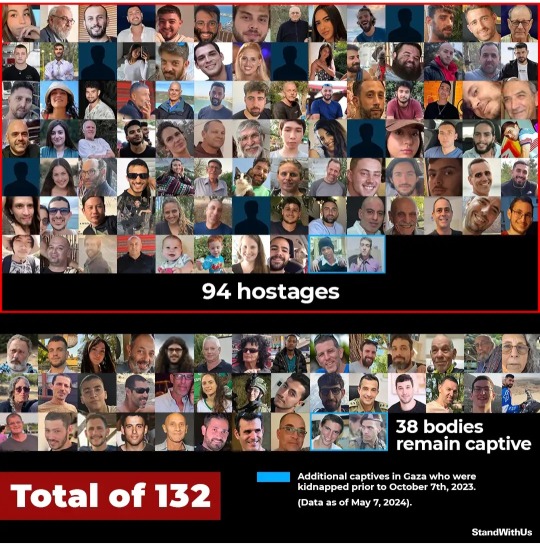
#bring them home now#israel#idf#hamas is isis#hamas war crimes#hamas massacre#heartstopper#alice oseman#israel hamas war#my truth#i stand with israel#pro israel#pro
20 notes
·
View notes
Text
The breakthrough hostages-for-a-cease-fire deal between Hamas and Israel was struck Wednesday because the terror group understood that the terms of any agreement under President-elect Donald Trump would be far worse, according to his incoming White House national security adviser.
“Clearly, the entire world recognizes that this was the Trump effect,” Rep. Mike Waltz (R-Fla.), who will serve as Trump’s principal adviser on all national security issues, told Fox News “Special Report” host Bret Baier.
Waltz argued that Hamas “had no choice” but to accept the deal, which will lay the path to freeing 33 hostages over the next 42 days in exchange for Israel releasing 1,000 Palestinians imprisoned in jails and pushing troops out of some parts of northern Gaza.
“They believed President Trump when he said there would be all hell to pay and any deal that was on the table would only get worse once he was in office,” the incoming White House national security adviser said of the terror group responsible for the Oct. 7, 2023, attack on the Jewish State.
“I mean, this is President Trump – who took out [Iranian Gen. Qasem] Soleimani, who took out [Islamic State boss Abu Bakr] al-Baghdadi – I think all these terrorist organizations understand now, the type of man and the type of leader that they’re dealing with,” Waltz said.
Waltz noted that he understands the concerns about the Palestinians being released as part of the deal but “at the end of the day, those hostages have been down there in those tunnels getting raped, abused, in horrific conditions.”
“They had been there longer than the 1979 hostages, and in much more horrific conditions,” he added, referring to the 53 Americans who were held hostage by Iran near the end of Jimmy Carter’s presidency.
Even Biden insiders admit it took Trump to close the cease-fire and Israel hostage deal
“I’m convinced they all would have died if President Trump hadn’t come in and said, ‘Get them out,’” Waltz said of the Hamas-held hostages, who have been in captivity for the last 15 months.
Waltz called the landmark agreement “a Reagan moment” for Trump, because Hamas “understood the consequences if they didn’t get this done.”
The Iranian hostages were released on Jan. 20, 1981, the day former President Ronald Reagan replaced Carter in the White House.
Waltz indicated that Trump, 78, will have no reservations about supporting Israel if it ends up needing to “go back in” to Gaza and conduct more operations against Hamas.
“We’ve made it very clear to the Israelis, and I want the people of Israel to hear me on this – If they need to go back in, we’re with them,” the Florida Republican said.
“If Hamas doesn’t live up to the terms of this agreement, we are with them,” he added.
Israel-Hamas cease-fire deal is back on after ‘last-minute crisis’ resolved: official
On the future of the terror group, Waltz was adamant that Hamas is “not going to continue as a military entity” and will have no role in governing Gaza should peace last in the region.
“I think by the end of President Trump’s term, we’re going to be talking about rail and fiber and data centers and moving the region forward. In a way that only President Trump could transform,” he added, referring to what the broader Middle Eastern region will look like under Trump.
5 notes
·
View notes
Text

Morarji Desai, Prime Minister of India (March 1977 to July 1979), was President of Ramana Kendra, Delhi, 1968-70.
I had the privilege of seeing Ramana Maharshi in August 1935 in the hall in which he usually sat. He was sitting on a sofa and wore only a loincloth. I could see an aura on his face, which was glowing with peace and joy. I sat opposite to him but did not ask him anything. He too did not say anything to me. I sat just over an hour and just looked at his face. Till today I have not seen that aura, that joy or peace on anybody else’s face. That hour of perfect stillness in that silent presence has been a precious memory ever since.
While I sat there, no questions arose in my mind, nor did I feel any desire to ask anything. I was at complete peace with myself. It was this experience that convinced me that Ramana Maharshi had realized God or Truth. Some of his disciples who were present asked him some questions, which he answered. He, however, said nothing of his own accord.
I had to leave the place next day by train at about twelve. About an hour-and-a half before the time of departure, I approached Ramana Maharshi for permission to leave. He told me that I should go after I had eaten. We sat down for lunch along with the Maharshi, at about eleven O’clock. After lunch, I bowed down to him and left.
The visit left an abiding impression on me and convinced me that Ramana Maharshi was a realized soul and that the ideal of ‘action in inaction’ as propounded in the Gita is really attainable.
Presiding over the 99th Jayanti celebrations of Ramana Maharshi at Ramana Kendra, New Delhi, on 13th January 1979, Morarji Desai as Prime Minister, said:
The Maharshi seemed to know everything. He knew the language of the animals. He listened to their complaints. He treated every being in the same way, whether it was a cow or a dog, a crow or a monkey. All were equal in his eyes, the beggar and the millionaire. He never went out of Tiruvannamalai. He refused to go out and preach. He said, “If I am a jnani, I consider everybody else a jnani too. What is there to give?” He regarded everybody as himself. He made no attempt to convert anybody. One got transformed by his very presence.
Many civilizations have flourished and then disappeared. But in this country, you find our old culture and the ancient religion still alive. And it is this that keeps the country alive. It is persons like the Maharshi who keep it alive...All learning should come from within. That is the way the Maharshi showed. He did not criticize others way of life. He said, “Stick to your own religion and follow it properly.” Ramana Maharshi taught that one could do sadhana in one’s chosen way and reach the goal.
- Face to Face
11 notes
·
View notes
Text


I keep referencing this scene from 1x8, so might as well make it easier for my self.
1692 Salem Witch Trials
1735 War for Independence (Our world: 1775-1783. The Molasses Act was passed in 1733, but was apparently routinely ignored before the end of the French and Indian War in 1763, and the resulting tensions ramped up until the riots began in 1772.)
1800 First Mexican War, 1810-1812 Second Mexican War (Our world: 1846-1848, after the Texas Revolution in 1836 and Mexico's own independence from Spain 1810-1821. In our world, the Louisiana Purchase was in 1803, leading to the Lewis And Clark and Pike Expeditions that decade. The UK supported Tecumseh's War in Indiana in 1811, rolling into the War of 1812, but which was the tail end of the Sixty Years' War era 1754-1813 of struggle between the UK, France, US, and Natives over the Great Lakes area.)
According to non-canon After The Storm, the Cession was created in the 1830s.
American Civil War 1840-1842 (Our world: 1861-65. As said above, in our world the 1840s was when the Mexican–American War took place.)
1908-1911 World War (Our world: WW1 1914-1918, Roaring 20s, Great Depression 1929-1939, WW2 1939-1945)
1940 The Hague (Our world: Notably, Geneva is not listed in this timeline, indicating that if Geneva was still a site of political importance, it wasn't to relevant witches. There were, however, also Hague Conventions of 1899 and 1907. The 1899 conference led to creation of the Permanent Court of Arbitration, and its housing, the Peace Palace, opened in 1913, also hosting many of the international organizations The Hague is known for today.)
1961-64 Chinese Civil War (Our world: 1927-49, with the US only making some minor moves about the Taiwan Strait.)
1960-present Proxy Wars (Our world: Cold War 1946-1991, NATO 1949, Korean War 1950-53, Vietnam War 1959-1975, Cuban Missile Crisis 1962, Moon landing 1969, Iranian Revolution 1979, Panama Invasion 1989, Gulf War 1990, Somalia and Bosnia/Herzegonia 1992, Haiti Invasion 1994, Kosovo 1996)
No mention of a Cold War or War on Terror (the latter not being surprising, given that it was replaced by the Spree)
Alder mentions the following locations as a part of "the early days" in 1x1:
Gibraltar (Great Siege 1779-83 stemming from Spain supporting the US in the Revolutionary War)
Tripoli (based on needing to have lifespan proximity to Gibraltar, this is about the Barbary Wars in the early 1800s between Ottoman Tripolitania and the US/Sweden)
Solomon Islands (rediscovered by Britain in 1767, Christian missionary work in the mid-1800s)
Alder's reminiscing from 2x9:
Bay of Bengal "running red with British blood", could be colonial or World War era.
Anatolian Plateau, probably about the Turkish War of Independence from the Ottoman Empire 1919-1923 after WWI, with Ankara becoming the new capital. Ankara is too far inland to be practical for the sea-based conflicts in the Barbary Wars and Aegean Sea conflicts. But there was also the Turkish "low-level civil war" 1976-1980.
Vienna, one summer, uhhhhhhhh probably World War events
Some other timeline notes:
1992 the Martyrdom in Liberia (Our world: immigration from the US with intent to colonize beginning in 1822, republic established 1847, coup in 1980, new republic in 1985, first Civil War 1989-1997, during which Greenville was destroyed.)
1994 Batan's bottles show up in Sudan (Our world: Sudan independence from Britain and UK in 1956, coup by al-Bashir in 1989, US sanctions in 1993)
1995 Batan's bottles show up in "in Minsk during the Belarus partition" (Belarus declared independence from the USSR in 1990, Lukashenko in 1994)
1997 First confirmed Spree attack
Some point in the 2000/10s: Bridey and her unit were in the Andes
Seven years ago (2012), per 1x6, Petra was in Belarus and encountered "The Balkan Composition".
The Balkan Composition was first deployed in "the Battle of the Urals", per 2x3
Willa and Quinn were stationed in Norilsk (a Russian city, west of the Urals) as a part of a siege at some point.
So what we see is that up to the World War, Alder's witch military mostly sped things up by a few decades (with the weird exception of the late 1700s/early 1800s, including Thomas Jefferson's presidency). Then, it seems that American hegemony would then delay/reduce much of the "modern" conflicts, or shift things around. Certainly, it seems that there was likely a large shift in the history of Eastern Europe and repercussions in East Asia.
#motherland fort salem#category: tv#I really really need to go back and add a mfs world building tag to the archives
8 notes
·
View notes
Text

AC/DC - Dirty Deeds Done Diet Cheap 17/12/1976
A brief history background on the AC/DC record that was released in no less than three different editions/pressings:
A modified international edition was released on Atlantic on 17th December 1976, although the label was unhappy with its vocals and production. (According to bassist Mark Evans, band manager Michael Browning told him he assumed Bon Scott would be fired as a result.) The band even teetered on the brink of being dropped. "The Atlantic A&R department [in the US] said, 'We're sorry, but this album actually doesn't make it,'" recalled Phil Carson, who had signed the band. "'We're not gonna put it out and we're dropping the band'… So I went to [Atlantic executive] Nesuhi (Ertegun) and showed him the sales figures that we'd got for High Voltage. They were not awe-inspiring but, considering we'd only paid $25,000 for the album, this was not so bad… Nesuhi backed me up and I re-signed the band at that point. I managed to claw it back in. Thank God."
As biographer Murray Engleheart observes in his book AC/DC: Maximum Rock & Roll, the band had not even toured the States yet, a market the band longed to conquer:
The tough rock acts only got what little airwave attention they did because they'd built up a fanbase through years on the road. AC/DC hadn't had the opportunity to marshal troops through touring the U.S., and at the time there was no way something as raw and gritty as Dirty Deeds was going to make it onto American radio playlists by itself. It was a brutally simple catch-22...Americans were said to have trouble understanding Bon, and if the people working with the band couldn't make out the lyrics, how was his voice going to work on the all-important U.S. radio networks?
Following the American success of Highway to Hell in late 1979, copies of the album began to appear as imports in the US. Some of these were the original Australian edition on Albert Productions; however, Atlantic also pressed the international version in Australia, and many of these were also exported to the US. Strong demand for both versions (in the wake of the even greater success of Back in Black) led the US division of Atlantic to finally authorize an official US release in March 1981. It went straight to No. 3 on the Billboard album charts.
However, the release was also poorly timed, considering that AC/DC had successfully reinvented itself with a new singer, Brian Johnson. The band was working on a new album, which would ultimately become For Those About to Rock We Salute You, released later that same year; the US release of Dirty Deeds was widely seen as damaging the momentum for that album, which it outsold. The band was forced to add songs from Dirty Deeds to its setlist on its subsequent tour, also taking the focus away from their new album.
In the book The Youngs: The Brothers Who Built AC/DC, author Jesse Fink quotes Phil Carson as saying that the release of Dirty Deeds was "one of the most crass decisions ever made by a record-company executive", blaming A&R man Doug Morris and his New York cohorts:
At the time, Doug's argument was purely financial. Back in Black had already sold over five million copies. Because of those numbers, Doug told me Dirty Deeds would sell at least 2 million. I told him he was right about that, but that it would also create a new sales plateau for AC/DC...God knows how many albums For Those About to Rock would have sold had Doug waited for that to come out.
The international release had significant variations from the original album. "Jailbreak" (which had preceded the LP's release in Australia and the UK) and "R.I.P. (Rock in Peace)" were jettisoned in favor of "Rocker" (from the 1975 Australian album T.N.T.) and "Love at First Feel". "Jailbreak" did not see a release in the United States, Canada, and Japan until October 1984 as part of the international '74 Jailbreak EP. A promo-only single, with "Show Business" as its B-side, was released to radio stations in the US at the time. "Love at First Feel" is one of only two tracks from international AC/DC albums not to be available on the band's Australian albums (the other is "Cold Hearted Man", released on European pressings of Powerage); however, "Love at First Feel" was released in Australia as a single in January 1977, with "Problem Child" as its B-side, which peaked in the Kent Music Report Singles Chart Top 100.
The international release of Dirty Deeds also contains "Big Balls", one of the band's most infamous compositions, that finds Scott, a deceptively clever lyricist, using double entendres by using ballroom and costume parties to obviously reference his own testicles. AC/DC had mined this territory before on "The Jack" and would again later on songs like "Given the Dog a Bone", but "Big Balls" could be their funniest attempt at sexual innuendo, although the song was controversial in its day and drew the ire of some critics who mistook the band's sense of humor for crude perversity. Dirty Deeds Done Dirt Cheap also led to more AC/DC appearances on Australia's Countdown music programme, following those in support of High Voltage and T.N.T. These appearances included a live performance of the album's title track, as well as a music video for "Jailbreak".
Two songs on the international album were edited from the full-length versions on the original Australian album. The full-length "Dirty Deeds Done Dirt Cheap" has the title of the song chanted four times, starting at 3:09, but on the edited version the chant is heard only twice. "Ain't No Fun (Waiting Round to Be a Millionaire)" lasted 7:29 on the Australian album but was faded out early to 6:57 on the international version.
This means they trim off the Chuck Berry licks and title chanting to the end; however, both these full-length versions were restored on the 1994 Atco Records remastered CD of the international album. The most recent 2003 CD edition by Epic Records goes back to the edited versions, as originally on the 1976 and 1981 international vinyl editions.
The uncut versions of both songs were released on the 2009 box set Backtracks. On the original version of "Rocker", included on the Australian T.N.T. album, the song lasts 2:55 and cuts out abruptly as the guitar riff hits its peak. Conversely, all international editions of the "Dirty Deeds Done Dirt Cheap" album have a slightly shorter version where the song fades out at 2:50 before the cut. "Squealer" appears to be longer by thirteen seconds on the international version; this is due to it having a bumper of silence at the end, as it is the final track on the record.
"Ride On" has a four-second difference (longer on the international version) which appears to be from a minor speed issue, although the last guitar slide can be heard better on the shorter Australian version.
#metalcultbrigade#artists on tumblr#art#hard rock#rock#classic rock#blues rock#ac/dc#ac dc#70's music#70's#70's rock
5 notes
·
View notes
Text

Summer (?) 1992. The final game supplement for the Mayfair Games DC HEROES ROLE-PLAYING GAME was a loose-leaf WHO'S WHO supplement, intended to complement DC's loose-leaf WHO'S WHO update. Only three of the four planned volumes were released before Mayfair lost the DC license. The first volume includes this entry for Legionnaire Brainiac 5, also covered in 2995: THE LEGION OF SUPER-HEROES SOURCEBOOK, which came out months later.
Brainy's game statistics are mostly the same (although this entry gives him 20 more Hero Points), but the special Psychological Instability rules are unique to this version. This wasn't really a problem anymore in the period when this supplement was published, since it really refers to one particular story from 1979 (a guy loses his shit and creates a universe-destroying super-monster ONE TIME and nobody ever lets him live it down …), but it's an interesting mechanic, so I can see why it was included. The reverse side also has a handy checklist of Brainiac 5 appearances, for completists:

The Personality/Role-playing section on the front side makes some dubious assertions. The first paragraph says:
He might be incredibly intelligent, but Brainiac 5 has a great deal of difficulty when it comes to expressing his emotions. When he first joined the Legion, he tried to concentrate on his feelings to fit in with his teammates, none of whom was Coluan. He even fell in love with Laurel Gand and spent a number of peaceful years with her. But inevitably, he became so overwhelmed with leading the team and protecting the universe that he was forced to forgo the luxury of emotion so that he could use his intelligence to its capacity.
While the 2995 sourcebook was written by Legion scripters Tom and Mary Bierbaum, this supplement was not, and I'm not sure what Winninger was talking about in the final sentence. What had happened in the latter third of the 1984–1989 Levitz series was that Brainy had fomented a conspiracy to avenge the death of Superboy by destroying the Time Trapper, one of the Legion's most powerful enemies, a plan that involved sacrificing Brainy's old friend Jaxon Rugarth. The other Legionnaires then put Brainy on trial for violating the Legion code, and although he was exonerated, he was so annoyed by their attitude that he resigned in a fit of pique and went back to Colu. He returned during the Magic Wars and sort of mended fences, although the team subsequently collapsed and he went on to other things during the five-year gap (principally trying to find a cure for the "Validus plague" afflicting Saturn Girl's kids). Some of the specific circumstances were subsequently retconned in ways not reflected in the actual comics, but that was still basically the gist at the time this supplement was published. It was messy, but it was certainly NOT a matter of his forgoing "the luxury of emotion."
The second paragraph says:
As a Brainiac, Dox has an affinity for pure logic. As time goes on, he seems less and less interested in establishing normal relationships with his teammates in the reformed Legion.
This was not at all true. Indeed, one of the charming aspects of the "Five Years Later" period was that Brainy had actually mellowed quite a bit. He was still a little awkward, and there was unresolved baggage between him and Laurel (who in the interim had had a baby with his best friend!), but he was more at peace with himself, and more patient with the people around him, than he'd ever been in past Legion stories. According to the Bierbaums' sourcebook, he was even writing sweet little haiku about his former teammates in his spare time — hardly the action of a cold-blooded logician.
#comics#who's who#mayfair games#dc heroes#brainiac 5#querl dox#legion of super heroes#legion of superheroes#laurel gand#the conspiracy storyline showed brainy being ruthless#but hardly unemotional#the actual game statistics are whatever#the dc heroes game designers tried three times to come up with workable gadgetry rules#none of them successful#and modeling a “super-genius” character like brainy in game terms is tough
25 notes
·
View notes
Text
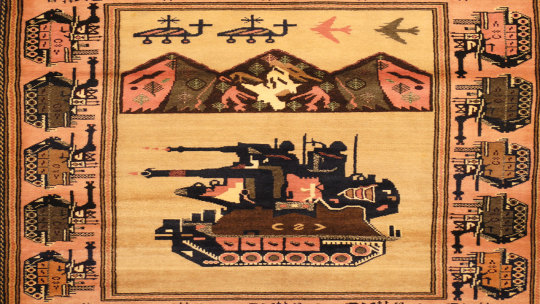
Attorney Mark Gold has an oriental rug in his western Massachusetts home that most people call “nice-looking” until he tells them to inspect it more closely. Then they’re enthralled, because this is no run-of-the-mill textile—it’s what is called an Afghan war rug, and what it depicts is somber and stunning: cleverly mixed with age-old botanical and geometric designs are tanks, hand grenades and helicopters. “It’s a beautiful piece in its own right,” says Gold, “but I also think telling a cultural story in that traditional medium is fascinating.”
The cultural story Gold’s rug tells is only the beginning. Since the Soviet invasion of Afghanistan in 1979, the country’s war rugs have featured not only images of the instruments of war, but also maps detailing the Soviet defeat and, more recently, depictions of the World Trade Center attacks.
It was women from Afghanistan’s Baluchi culture who, soon after the arrival of the Soviets, began to weave the violence they encountered in their daily lives into sturdy, knotted pile wool rugs that had previously featured peaceful, ordinary symbols, such as flowers and birds. The first of these rugs were much like Gold’s, in that the aggressive imagery was rather hidden. In those early years, brokers and merchants refused to buy war rugs with overt designs for fear they would put off buyers. But with time and with the rugs’ increasing popularity, the images became so prominent that one can even distinguish particular guns, such as AK-47s, Kalashnikov rifles, and automatic pistols.
A decade later, the Soviets withdrew from Afghanistan, and rugs celebrating their exodus appeared. Typical imagery includes a large map with Soviet tanks leaving from the north. These rugs, principally woven by women of the Turkman culture, often include red or yellow hues and are peppered with large weapons, military vehicles and English phrases such as “Hand Bom [Bomb],” “Rooket [Rocket]” and “Made in Afghanistan.”
To many, this script is a firm indication of the rugs’ intended audience: Westerners, and in particular, Americans, who funded the Afghan resistance—the Mujahadeen—during the Soviet occupation. “The rugs are geared for a tourist market,” says Margaret Mills, a folklorist at Ohio State University who has conducted research in Afghanistan since 1974. “And they verbally address this market.” Sediq Omar, a rug merchant from Herat who dealt in war rugs during and after the Soviet occupation, agrees. “Afghanis don’t want to buy these,” he says. “They’re expensive for them. It’s the Westerners who are interested.”
While this may be true, it’s likely that the first “hidden” war rugs from the early 1980s were meant for fellow Afghanis, according to Hanifa Tokhi, an Afghan immigrant who fled Kabul after the Soviet invasion and now lives in northern California. “Later on, they made it commercialized when they found out that people were interested,” she says. “But at the beginning, it was to show their hatred of the invasion. I know the Afghan people, and this was their way to fight.”
Kevin Sudeith, a New York City artist, sells war rugs online and in local flea markets for prices ranging from $60 to $25,000. He includes the World Trade Center rugs in his market displays, and finds that many passersby are disturbed by them and read them as a glorification of the event. “Plus, New Yorkers have had our share of 9/11 stuff,” he says. “We all don’t need to be reminded of it.” Gold, a state away in Massachusetts, concurs. “I appreciate their storytelling aspect,” he says. “But I’m not there yet. It’s not something I’d want to put out.”
Yet others find World Trade Center rugs collectable. According to Omar, American servicemen and women frequently buy them in Afghanistan, and Afghani rug traders even get special permits to sell them at military bases. Some New Yorkers find them fit for display, too. “You might think it’s a ghoulish thing to own, but I look upon it in a different way,” says Barbara Jakobson, a trustee at Manhattan’s Museum of Modern Art and a longtime art collector. “It’s a kind of history painting. Battles have always been depicted in art.” Jakobson placed hers in a small hallway in her brownstone.
In an intriguing twist, it turns out the World Trade Center rugs portray imagery taken from U.S. propaganda leaflets dropped from the air by the thousands to explain to Afghanis the reason for the 2001 American invasion. “They saw these,” says Jakobson, “and they were extremely adept at translating them into new forms.” And Nigel Lendon, one of the leading scholars on Afghan war rugs, noted in a recent exhibition catalog that war rug depictions—both from the Soviet and post-9/11 era—can be “understood as a mirror of the West’s own representations of itself.”
If Afghanis are showing how Americans view themselves via World Trade Center war rugs, Americans also project their views of Afghan culture onto these textiles. In particular, the idea of the oppressed Muslim woman comes up again and again when Americans are asked to consider the rugs. “Women in that part of the world have a limited ability to speak out,” says Barry O’Connell, a Washington D.C.-based oriental rug enthusiast. “These rugs may be their only chance to gain a voice in their adult life.” Columbia University anthropology professor Lila Abu-Lughod takes issue with this view in a post-9/11 article “Do Muslim Women Really Need Saving?” She notes the importance of challenging such generalizations, which she sees as “reinforcing a sense of superiority in Westerners.”
Whether in agreement with Abu-Lughod or O’Connell, most conclude that the women who weave Afghan war rugs have a tough job. “It’s very hard work,” says Omar. “Weavers experience loss of eyesight and back pain—and it’s the dealers who get the money.”
But as long as there’s a market, war rugs will continue to be produced. And in the U.S., this compelling textile certainly has its fans. “These rugs continue to amaze me,” says dealer Sudeith. When I get a beautiful one, I get a lot of pleasure out of it.” And Gold, who owns five war rugs in addition to the hidden one he points out to visitors, simply says, “They’re on our floors. And we appreciate them underfoot.”
Mimi Kirk is an editor and writer in Washington, D.C. {read]
#smithsonian#article#USSR#propaganda#war#russian imperialism#us imperialism#imperialism#rugs#art#craft#21st century#20th century#Afghanistan
5 notes
·
View notes
Text
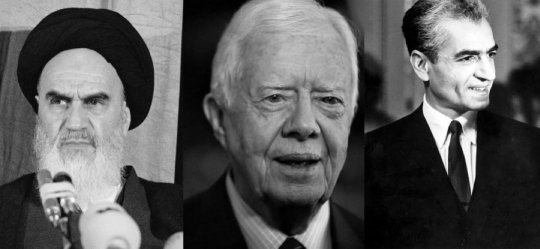
Jimmy Carter destabilized Iran and helped overthrow the Shah, resulting in the Islamic Revolution and the loss of one of the most important allies of the US in the Middle East.
In 2016, the BBC published a report that exposed the Carter admin’s extensive contact with Khomeini prior to 1979.
According to the report, Khomeini went to great lengths to convince the US not to jeopardize his plan to rule Iran:
“It is advisable that you recommend to the army not to follow [Shah’s prime minister Shapour] Bakhtiar,” Khomeini said in one message, according to the BBC.
"You will see we are not in any particular animosity with the Americans," said Khomeini in another message, pledging his Islamic Republic will be "a humanitarian one, which will benefit the cause of peace and tranquillity for all mankind".
In another message sent via a US emissary, Khomeini assured the Carter admin that their economic interests would not be impacted if he was granted power in Iran: “There should be no fear about oil. It is not true that we wouldn’t sell to the US.”
According to the report, in turn, Carter helped Khomeini and made sure that the Imperial Iranian army would not launch a military coup.
Khomeini returned to Tehran on February 1, 1979, just two weeks after Carter convinced the Shah to take a “vacation” and leave Iran.
The Iranian military, which was under US influence, surrendered, and within months Khomenei was declared the Supreme Leader and the Islamic Regime was born.
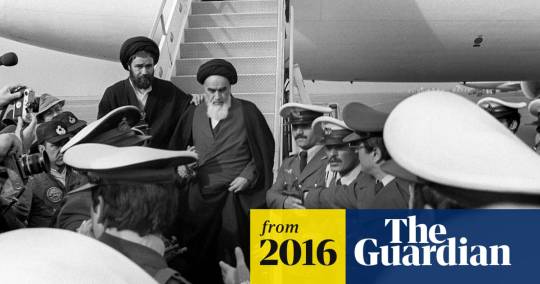
Link. Link

117 notes
·
View notes
Text
Has the U.S. Fuelled the Israel-Palestine Conflict Throughout History, and is it Complicit in Genocide Now?

Figure 1: Map of Israel and Palestine (Gaza, West Bank)
When creating Israel, land was taken from the Palestinians, leaving many displaced, who were driven out by Zionist military forces leading to Arab life (especially in the coastal cities of Jaffa and Haifa) virtually disintegrated. The center of Palestinian life is now situated in the area of the Gaza Strip and the West Bank. However, since its inception, Israeli settlers have been encroaching on areas like the West Bank, murdering those who resided there. Following the brutal October 7th Attacks, carried out by Palestinian terrorist group, Hamas, that left 1,400 Israeli citizens dead and many more taken hostage, the Israeli government has waged an unprecedented bombing campaign in retaliation. Whilst Israel has a right to defend its citizens, collective punishment is a war crime and legal experts have argued Israel’s actions may also amount to crimes against humanity and genocide, as defined under the 1948 Genocide Convention. Additionally, there is a case to be made that the ongoing and unconditional U.S. military, diplomatic, and political support for Israel may make the U.S. complicit in genocide. Given the shifting of views on Israel, and Israeli Prime Minister Benjamin Netanyahu’s war crimes arrest warrant issued by the International Criminal Court (as well as warrants for his former defence minister, Yoav Gallant, and Hamas commander, Mohammed Deif), it seems like the conflict, that once seemed so cut-and-dry, is ready for a re-analysis. Focusing on the U.S.A.’s historical support of Israel and the extent of its support today, as well as the motivations and consequences of U.S. involvement in the conflict, there’s the question of whether America’s intervention in the conflict has heightened or helped to decrease tension.
The USA’s support for the establishment of Israel dates back to the 14th of May in 1948, only eleven minutes after its creation. President Truman was the first world leader to recognise it as a legitimate Jewish state. Since its creation, Israel has received $158 billion in military aid from the United States, making it the greatest recipient of their military assistance in history. Furthermore, the USA has played a key role in the promotion of good relations between Israel and its neighbouring Arab states – particularly Jordan, Lebanon and Egypt – whilst holding off hostility from countries such as Syria and Iran. The U.S.A., as one of the biggest global superpowers helped to secure Israel’s future as a legitimate state. Due to America’s perceived ‘special relationship’ with Israel, by the mid-1960s, Israel was considered a strategic proxy of American power in the Middle East during the Cold War. Furthermore, the USA had broad influence in the Middle East, especially during Carter’s presidency as he brokered the Camp David Accords. Peace talks had stalled between Egyptian President Anwar Sadat and Israeli Prime Minister Menachem Begin and Carter proposed that the three of them meet at the Presidential retreat at Camp David in September. The agreement was comprised of two parts: a framework for peace between Egypt and Israel; and a framework for negotiations on Palestinian autonomy. The peace treaty, the first for Israel and any of its Arab neighbours, was signed in March of 1979 but the Palestinian autonomy talks ultimately stalled, in large part to Israeli intransigence. Egypt’s peace with Israel stifled Palestinian’s greatest source of pressure on Israel to negotiate fairly. Furthermore, the United State’s forfeiting of the chance to involve the Palestine Liberation Organization in the negotiations gave the Soviets an opportunity to reassert their importance in the Middle East. Despite their previous caution about the Palestine Liberation Organization, the Soviet Union armed Arab nationalist states and endorsed a Palestinian “people’s war of national liberation” against Israel, furthering tensions between Israel and Palestine. 1993 saw the creation of the Oslo Accords and the Palestinian Authority (PA), an attempt from the USA to create an interim self-government for five years while negotiations commenced for a two-state solution (an establishing of two self-governing states: Israel for the Jewish people and Palestine for the Palestinians). However, the two-state solution failed to materialise within the intended timeframe since the Israel offered only 18% of the West Bank to be used as an independent Palestinian state whilst 22% would be governed together and 66% would be owned by the Israelis. These talks didn’t produce a viable Palestinian state and Israel would’ve have had to dismantle their settlements in the West Bank and Gaza. Furthermore, the Palestinian Authority lacks the power to force Israel to stop expanding on land wanted for a future Palestinian state. Decades on from the Oslo Accords and it seems to be nothing more than superficial intervention from the U.S. and false hope for Palestinians. Historically, when it came to the Middle East, Israel has consistently had the support of the USA – even now, President, Joe Biden calling Netanyahu’s arrest warrant “outrageous”.
Looking at current U.S. policies and actions, Israel, as previously mentioned, is the largest recipient of aid from the USA, having received $158 billion since its creation. Previously, the United States provided economic assistance until 2007, but now nearly all U.S. aid goes to support Israel’s military – the most advanced in the region. Furthermore, there’s an agreed memorandum of understanding (MOU) to provide Israel with $3.8 billion per year through to 2028. In terms of direct military aid to Israel, the U.S. has provided at least $12.5 billion in direct military aid (comprised of $3.8 billion from a bill in March of 2024, in line with the current MOU, and $8.7 billion for a supplemental appropriations act in April 2024). Analysts from Brown University reported that Israel has received a further $17.9 billion in U.S. military aid during this period and since the October 7th attacks, the United States has quietly approved and delivered more than 100 separate foreign military sales to Israel. This consists of thousands of precision-guided munitions, small-diameter bombs, bunker busters, small arms, and other lethal aid according to what U.S. officials told members of Congress in a classified briefing. Only six of these hundred military aid transfers have been made public, including $106 million worth of tank ammunition and $147.5 million of components needed to make 155mm shells and was met with public scrutiny due to the Biden administration bypassing Congress to approve the packages by invoking an emergency authority.
Moreover, one of Israel’s most significant and best-known weapons in their arsenal is the Iron Dome missile shield. Designed to intercept short-range rockets at a range between 4km and 70km, there are Iron Dome batteries across Israel, each with three or four launchers containing 20 interceptor missiles each. The U.S. contributed directly to the development of the Iron Dome by providing over $1.6 billion in funding for it. In addition to the $3.8 billion military financing that the U.S. provided to Israel in 2021, the House of Representatives also voted to provide Israel with $1 billion in new funding for the Iron Dome. It seems the U.S.’s intervention in the Middle East consists of further militarisation of Israel instead of investment in peaceful alternatives and this choice seems further strange when you consider that there is no urgent need for these funds, and they instead get put into a slush fund that Israel could use at any point. Moving onto U.S. diplomatic efforts, in 2020, under President Trump, the Abraham Accords were created. They were a series of agreements that normalised relations between Israel and the U.A.E., Bahrain, Sudan, and Morocco, who historically aligned more closely with Palestine. The U.S.A. acted as a mediator, offering economic aid, arms deals, and other incentives such as political recognition (in this case, Morocco’s claim over Western Sahara). Whilst it broadened regional acceptance of Israel and set a precedent for diplomatic solutions in the Middle East, it bypassed Palestinian interests, with no progress towards resolving the core conflict and fostering a Palestinian sense of betrayal towards the other Arab nations. With the Abraham Accords raising questions about the U.S.’s long-term commitment to a two-state solution, there was a sense of hope recently for Palestinians in the West Bank as Joe Biden’s administration issued a round of sanctions against illegal Israeli settlements, the settlements are backed by the Israeli government itself making it difficult to make the sanctions have an effect. To make matters worse for the Palestinians in West Bank, President-Elect Trump has named staunch Israeli settlement supporters to his incoming cabinet. Arkansas Governor Mike Huckabee has been appointed as the US ambassador to Israel and has previously stated there is “no such thing as a West Bank”. This further calls into question the U.S.A.’s commitment to a two-state solution and has caused unrest for Palestinians – no doubt concerned with their future in the face of Israel’s increasing support.
When questioning U.S. motivations for intervening in the Middle East, one should consider their strategic interests, domestic influences, and the humanitarian and democratic justifications. For almost a century, the US has been present in the Middle East in one way or another, asserting itself as a significant player in the region. There is a geopolitical importance surrounding the Middle East and this is partially because the Middle East is a resource rich region – having one of the world’s largest sources of petroleum in Dhahran, Saudi Arabia, and so control over oil-rich areas means control over other countries’ access to oil. The second reason is money as America selling arms to Middle Eastern countries made up 40% of global arms sales in 2023, setting a record $238 billion in revenue. In Israel’s case, any aid sent to them by the U.S. can only be used to buy U.S. military equipment – meaning the U.S. have strategic power within Israel. Another reason for the Middle East’s geopolitical importance is alliances. The Middle East was a major theatre of the Cold War and Russia still has military presence in confrontation zones such as Syria and so it was always important America’s commitment to Israel was unparalleled to secure an alliance. Furthermore, events like the War on Terror and the Invasion of Iraq furthered America’s need for allies within the region as they attempted to prevent any major challengers to their hegemony in the Middle East. Domestically, there are pro-Israel lobbying groups, such as the American Israel Public Affairs Committee (AIPAC) that’s called one of the most powerful lobbying groups. They keep Republican and Democratic lawmakers on their side using all-expenses-paid trips for members of Congress and that allegiance was on full display as the Biden administration and most members of Congress have backed Israel amid its genocide. Furthermore, humanitarian and democratic ideals have long been central to U.S. justifications for its involvement in the Israel-Palestine conflict. Israel is portrayed as a stable democracy in a region often characterised by authoritarian regimes and so, by emphasising shared democratic values with Israel, the U.S. seeks to frame its actions as morally principled. However, this rhetoric is questioned by critics who point to the disproportionate support for Israel, arguing this enables practises that undermine Palestinian human rights and any aid to Palestine is inconsistent such as fluctuating support for refugee programs.
Undeniably, the U.S. favours Israel considerably and, when analysing the consequences of U.S. involvement, the case could be made that the U.S. has contributed directly to an escalation of violence. Israel makes frequent use of drone technology as well as advanced munitions and weapons whilst Hamas has made itself one of the most heavily armed guerrilla organisations in the world in an attempt to keep up with Israel’s evolving arsenal of weapons. By supplying Israel with weapons and military funding, it contributes directly to an ongoing cycle of violence and, furthermore, reduces incentives for compromise on Israel’s side. Furthermore, U.S. involvement affects the lives of those living in Palestinian territories as Israeli security measures, supported by U.S. funding, restrict movement and economic growth. However, U.S. aid programs have helped alleviate some of the hardships such as the U.S. airdropping food and other supplies into Gaza or building a temporary port to allow aid to arrive by sea though critics argue these measures wouldn’t need to be in place if the U.S. took a more hardline intervention in the conflict rather than fuelling it. Furthermore, the Abraham Accords, as previously discussed, lead to Arab nations prioritising their relationships with Israel over solidarity with Palestine, and this is, in large part, influenced by U.S. intervention. Whilst the repercussions of U.S. intervention is felt predominantly in the Middle East, the U.S. does face an impact on its international reputation as its pro-Israel stance has caused friction with European nations and other global powers advocating for stronger Palestinian rights as critics argue the U.S.’s selective application of humanitarian values, such as its strong backing of Israel, while downplaying Palestinian suffering, reveals its hypocrisy. It has also increased terror recruitment. In December of 2023, German and Dutch authorities arrested four members of a Hamas cell, who cited the war as a motive for their actions, plotting to attack European Jewish institutions and experts are concerned this could inspire terrorist organisations to target the U.S. homeland. As the U.S. intervene further in the Israel-Palestine conflict, consequently, they have hindered peace efforts as well as damaged their own reputation and their safety on the world stage.
When analysing the U.S.A.’s intervention in the Israel-Palestine conflict, purports of the idea that Israel is not carrying on a genocide state that the casualties in Gaza are merely a byproduct of war rather than it being a genocide. One could argue that if World War II didn’t count as a genocide of the Germans, then neither does the retaliation against Gaza. Furthermore, supporters of Israel argue that Hamas have lied about the number of deaths to garner sympathy and support. Moreover, they argue October 7th set a precedent that Israel needs to defend itself. Therefore, there is an argument to be made that the U.S.A.’s involvement is simply to ensure there is justice and protection for Israel after the loss of lives. However, whilst October 7th is an undeniable tragedy, there is a case to be made, by those in favour of Palestine’s freedom, that Palestinians have suffered more than 100 years of violence, brutality, and racist laws at the hands of Zionist settlers on Palestinian land. One could make the case that October 7th, despite its tragedy, was an inevitable lashing out bought on by mistreatment from Israel and the U.S.. Furthermore, civilians are not to blame and should not suffer for Hamas’ horrific terrorism. Whilst the U.S.A.’s has made some relief efforts in Gaza, as previously mentioned, majority of their help for Palestinians came in the form of “peace deals” – like the aforementioned Oslo Accords – that have only helped to enshrine Israel’s hold over the land under the pretence that Palestine would be handed a state that could exist alongside Israel. However, under U.S. supervision, Israel has strengthened its own one-state solution whilst seizing homes and land from Palestinians. Furthermore, the U.S. has been met with criticisms from global human rights organisations, like Amnesty International, who, following investigation, concluded that Israel is committing a genocide against Palestinians in Gaza. The Secretary General of Amnesty International said that “States [continuing] to transfer arms to Israel [are becoming] complicit in genocide… Key arms suppliers like the USA and Germany, but also other EU member states, the UK and others, must act now to bring Israel’s atrocities against Palestinians in Gaza to an immediate end”. There is large criticism of the U.S., from those in favour of Palestine’s freedom, as many feel their presence in the Middle East and Israel has fostered a genocide yet are hesitant to stop it.
To conclude, the evidence supporting the idea that the U.S. has heightened the tension in Middle East and is culpable in the genocide of the Palestinians is damning. From its creation to the present, Palestinian interests have been ignored whilst its land has been stripped from them and their people have been massacred. Now, using Hamas’ attacks as a casus belli, Israel have begun an onslaught of attacks against innocent civilians, including children and the elderly. Instead of ending the genocide, the U.S. is funding it, due to its own motivations for an alliance with Israel, and its intervention makes it more than complicit in the many deaths that the world is bearing witness to.
2 notes
·
View notes
Text
The temptation to see the Hamas attack of Oct. 7 as a profoundly transformational event in the history of the Israeli-Palestinian conflict and the Middle East is irresistible, and it’s easy to see why.
The attack—including the killing of 1,200 Israeli civilians and soldiers, the reported rape and torture of women and girls, and the taking of some 250 hostages, many of whom have been abused or died in captivity—demonstrated the group’s brutal sadism. Israel’s response—a siege of Gaza depriving an already impoverished population of basic necessities followed by weeks of airstrikes and months of ground combat—has killed nearly 30,000 Palestinians, around two-thirds of them women and children; Israel estimates that it has killed some 10,000 Hamas fighters.
As if these events weren’t potentially transformational enough, escalation by Hezbollah along the Israeli-Lebanese border; attacks by Houthis against international shipping in the Red Sea; and pro-Iranian militia strikes against U.S. forces in Syria, Iraq, and Jordan has raised the specter of something the modern Middle East has never experienced—a truly regional war. Apart from the 1948 Arab-Israeli war, the Israel-Hamas war is already the longest ever fought.
The transformative character of what Oct. 7 set in motion seemed to many brutally clear. “There’s no going back to the status quo as it stood on Oct. 6,” U.S. President Joe Biden said on Oct. 25. “Israel was one country on Oct. 6 and another on Oct. 7,” Michael Herzog, Israel’s ambassador to the United States, said in late October. Jordan’s King Abdullah warned darkly that the “whole region is on the brink of falling into the abyss.”
These predictions may or may not prove to be true. Six months into this crisis, we do not even know where we are on the conflict’s trajectory or where it’s headed. CIA Director Bill Burns, a friend and colleague of one of the authors, who’s not prone to exaggeration, deemed this the most dangerous and tangled conflict he’d witnessed in decades.
Yet the Middle East has often proved to be unpredictably predictable. It is true that crisis can scramble the playing field, often with horrific consequences—but sometimes with positive outcomes. Almost every breakthrough in the Arab-Israeli arena was preceded by intense violence. The 1973 war led to Egyptian-Israeli peace; Saddam Hussein’s invasion of Kuwait produced the Madrid peace conference; and the First Intifada resulted in the Oslo Accords.
But we may not be as fortunate this time around. Two deeply traumatized communities will emerge from this crisis, and at the moment both are lacking the kinds of leaders essential to transformational change. It’s worth asking whether the region’s legendary resistance to change and the absence of leaders willing to take real risks, including those in Washington, will yield a new status quo that’s much like the one so many hoped to leave behind.
Much remains to be sorted. But several looming factors suggest that the new, post-crisis Middle East may look strikingly like the old one.
Every State Department decision memo begins: “The United States has three broad options.” The joke, of course, is that these are “nuke them,” “surrender,” or whatever the drafter’s favored alternative was, aka “my option.” The poor addressee is inevitably herded toward that one. The first two have the virtues of finality; the third is just an uninspiring nudge to muddle through. ‘Twas ever thus, at least regarding Iran since the 1979 Islamic Revolution. Attempts to break the mold by Ronald Reagan and Barack Obama ended in scandal or swift reversal.
The options menu doesn’t look very different now, as Iran has seized on the Gaza crisis to use its axis of resistance—a jumble of groups including Hezbollah in Lebanon, Shiite militias in Iraq and Syria, and the Houthis in Yemen—to stir up trouble for Israel and the United States. The notable feature of the current confrontation, however, is the relative restraint exercised by these parties, except for the Houthis. The main players have too much to lose by an all-out fight and have signaled publicly and privately that they wish to avoid one. Instead, they have contented themselves with a sustained level of violence just below the threshold of escalation. But the threshold is in the eye of the beholder—hence the persistent risk of inadvertent escalation.
Since the crisis began, diplomatic efforts by the United States and France have laid the basis for a more durable, formal arrangement on the Blue Line between Israel and Lebanon. The deal would trade a withdrawal of Hezbollah’s Radwan storm troops from the line for territorial adjustments that favor Lebanese claims. Lebanese Army units would deploy to the south in lieu of Hezbollah forces. These talks have stalled but will likely resume.
In Iraq, the main Iran-aligned militia proposed a truce, and a mini-groundswell for the expulsion of U.S. forces has receded. Persian Gulf waters have been relatively calm. Saudi Arabia and the United Arab Emirates have indicated that a U.S. war with Iran would be unwelcome. In Syria, Israeli air power continues to thwart Iranian maneuvering; Iran has withdrawn senior Revolutionary Guard personnel because it cannot protect them. In the Bab el-Mandeb strait, U.S. and U.K. strikes and the interdiction of Iranian resupply efforts are slowly chipping away at the Houthis’ coastal infrastructure, if not their stockpiles, and will eventually drive an end to the mayhem in the Red Sea, if an Israel-Hamas cease-fire doesn’t do so first.
Bottom line: An escalatory spiral that fundamentally alters pre-Oct. 7 geopolitical dynamics does not seem to be in the cards—though a new hand can always be dealt.
Even in Gaza, where Israel continues its grinding military campaign, a political change is hardly guaranteed. Perhaps the most candid assessment of the fate of Hamas comes from an Israeli intelligence document, widely circulated among the political echelon. The bottom line: “Hamas will survive this [Israel Defense Forces] campaign as a terror group and a guerrilla group.”
There’s no doubt that Hamas has been profoundly weakened as a military organization, and its capacity to pull off another Oct. 7 is greatly impaired. And while polls suggest that its popularity has surged in the West Bank, its standing in Gaza was compromised well before Oct. 7 as a result of its bad governance—but saw a minor surge afterward. Hamas benefits from being the only organized alternative to a bankrupt and sclerotic Palestinian Authority. Should its top leadership inside Gaza be eliminated, its viability will suffer.
None of this should suggest that Hamas’s capacity to influence Palestinian politics inside and outside Gaza has been fundamentally eroded and that it won’t be a factor in the proverbial day after. The most recent authoritative poll revealed that a majority of Palestinians in Gaza believe Hamas will win the war and resume its rule.
Why is Hamas still relevant when its policies have brought such suffering to Palestinians? First, Palestinians are more likely to blame Israel for their misfortunes rather than their own leadership. Polls show clearly that a majority of Palestinians believed the Hamas attack was justified by the Israeli occupation. Second, Hamas’s resilience is linked to the dysfunction of the PA and a sense that any post-conflict government must be based on a national consensus that would include all factions, including Hamas.
The awkward reality is that under current circumstances, there’s little chance of the PA—revitalized or otherwise—returning to govern Gaza without Hamas consent.
Then there’s the Israeli factor. It’s hard to imagine a better recruiting agency for Hamas’s extremism than the current Israeli government. Hamas is the organizational embodiment of an idea—the end of Israel and its replacement with an Islamic state. The majority of Palestinians in the West Bank and Gaza do not subscribe to this goal. But the fecklessness of the PA, combined with Israel’s annexationist policies, offers Hamas a pathway to dominion over the Palestinian national movement.
Throughout, one inconvenient truth remains: Without a Palestinian national movement committed to functional governance and in control of the West Bank and Gaza with a monopoly on the legitimate use of force, sovereignty and statehood are pretty much inconceivable.
It’s understandable that many would assume that the days of an Israeli leader who presided over the worst attack in the nation’s history and the bloodiest day for Jews since the Holocaust would be numbered. That assessment may well prove correct. But even if and when Prime Minister Benjamin Netanyahu leaves office, his successor may have less leeway to make key decisions. That a majority of Israelis are tired of Netanyahu does not mean they are drifting leftward, oppose his approach toward Hamas, or support Palestinian statehood. More than 90 percent of Israeli Jews believe that the government is using the right amount of force against Hamas or should use more. Nor is there any viable mechanism for removing Netanyahu from power. His right-wing government isn’t about to end itself, and his main rival, Benny Gantz, remains seated at Netanyahu’s side in the war cabinet. For the foreseeable future, Netanyahu remains in charge.
Indeed, if the past is prologue in Israeli politics, the trend lines after a major crisis suggest a strong tendency to move to the right. Israel is already a right-wing or right-center country. After almost every military and security crisis, rightist parties have gained support.
In some case, crises can produce surprises. Few would have predicted that in the wake of the 1973 Arab-Israeli War, Egypt’s Anwar Sadat would make a bid for peace or that Israel’s Menachem Begin would grasp it. But compared with the 1970s, today’s environment would not appear to favor bold decision-making on the Israeli side, Palestinian, or U.S. side. More than 100 hostages remain in Hamas hands; more than 200,000 Israelis have been temporarily relocated from the northern and southern border communities with little prospect of returning anytime soon. The threat of war with Hezbollah remains a constant concern—and for some Israelis, a necessity—and there’s little doubt that Israel will be operating in Gaza for months to come, as will Hamas insurgents. Even in the relatively quiet West Bank, attacks by Hamas and other groups, settler violence and vigilantism, and expanding Israeli settlements conspire to make any change of the situation unlikely.
Some point to the promise of a Saudi peace offer and with it reconciliation with the entire Arab world as a salve for the collective PTSD among Israelis induced by Oct. 7. But grand plans don’t necessarily produce grand results. The Biden administration’s scheme to transform the Middle East—a mix of low-income, high-population states and high-income, low-population states—by uniting the region’s richest country and its most technologically advanced one in a quest for intraregional trade, labor mobility, and infrastructure investment is certainly ambitious. But it’s also untethered from the realities of Middle Eastern governance and environmental conditions. That this vision is predicated on an enduring resolution of the Israeli-Palestinian conflict, which is in turn premised on unlikely developments in Israeli and Palestinian domestic politics, confers a surreal quality to claims about transformation.
Not that it would be a bad thing for Saudi Arabia and Israel to make peace and money together, but given foreseeable realities, normalization is most likely to reinforce Netanyahu’s political position and deal yet another blow to Palestinian aspirations. Whether it makes sense for the United States to offer a binding security guarantee to Saudi Arabia depends entirely on the reliability of a mercurial Saudi leader like Mohammed bin Salman to radically shift the direction of Saudi policy. He would be expected to abandon Saudi support for Russia within OPEC+, moderate production cuts with U.S. economic needs in mind, and distance the country from China, its largest energy market. Given the crown prince’s track record, his willingness to abide by these obligations even in the short term seems unlikely.
All in all, if you’re anticipating transformation, an old Spanish proverb comes to mind: “Best to wait sitting down.”
If the Gaza crisis and its aftermath do represent a horrific glitch in an otherwise immutable matrix, there is not a great deal the United States can do. As always, the belligerents have a lot more agency than outside powers. For the most part, the Biden administration understands this, but the results have been, at best, bittersweet. Some of Biden’s measures have worked to avoid making an extremely dangerous situation worse. They include the swift deployment of naval power and its subsequent redeployment; patience in the face of attacks followed by a measured response; not increasing the U.S. ground presence in the region in response to provocation; creative diplomacy to reduce the risk of escalation in the north; avoiding a drastic response to Houthi shipping attacks while trying to keep communication going; and maintaining constant, if largely ineffectual, pressure on Israel to shift its operational approach in Gaza, facilitate humanitarian assistance, and not try to push Palestinians to Egyptian territory. The fact that a relatively coherent response could be fashioned given the state of party politics in the United States is in itself remarkable. Yet the ghastly reality of tens of thousands of Palestinians dead and a shattered landscape cannot in any sense be described as a ringing foreign-policy success. It will haunt us.
Going beyond these moves, however, won’t be possible without Israeli and Palestinian commitments. And that seems scarcely likely at this juncture or indeed in the absence of a sea change in Israel’s state and society. If there was a sea change, it happened on Oct. 7. A reversal of the tide seems unlikely given the massacre of Israelis. It will be used by the Israeli right to validate its worldview of beleaguerment and its message that the world is roiled by hypocrisy and antisemitism. And there are no regional Arab powers, especially Saudi Arabia, willing and able to serve as the deus ex machina on this bleak stage.
Finally, there is the question of U.S. domestic politics. The Gaza crisis has divided Democrats and unified Republicans in the face of a consequential election. In the region, Israel and the Gulf states would welcome a Trump presidency. Thus far, the Biden administration has been preoccupied by the region’s turmoil, while the Trump campaign has not yet focused on the crisis. The campaign season, however, will undoubtedly make its presence felt as the United States and regional parties plot their next moves.
7 notes
·
View notes
Text


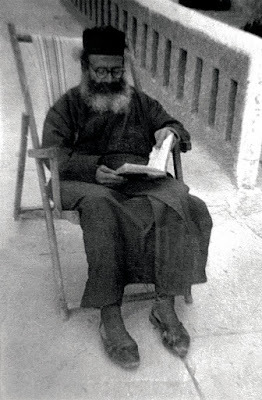
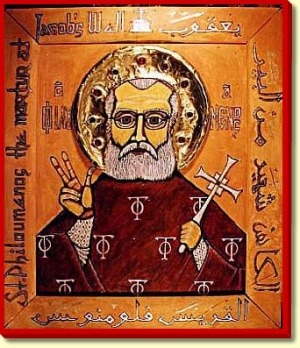

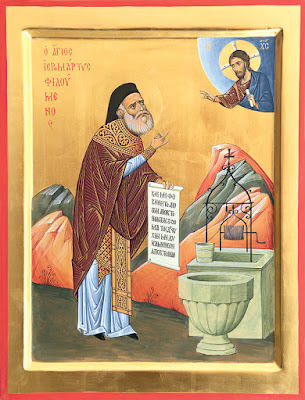

Holy hieromartyr Philoumenos of Cyprus (1913-1979) †
"Saint Philoumenos was born on October 15th, 1913 in the parish of Saint Savvas in Nicosia, along with his twin brother Archimandrite Elpidios.
At the age of 14, the two brothers left for the ancient Monastery of Stavrovouni, and stayed there for five years. Later, the saint joined the monastic brotherhood of the holy sepulchre. In 1979, he was appointed guardian of the monastery of Saint Jacob´s Well.
In the afternoon of November 29th, 1979 - “strangers”, according to the police report, trespassed on the premises of Jacob’s Well. They found the opportunity to hide and remain in the monastery after 4:00 p.m. when the guard had already left. Possibly while the Saint was performing vespers, they attacked him with an axe, and having fiercely abused him, they killed him.
The body of the Saint was handed over to the Orthodox 6 days after his massacre, but retained its flexibility and was buried in the cemetery of Mount Zion.
૮ ◞ ﻌ ◟ ა 3 things were most remarkable about the blessed martyr. The first might have been partly from nature: this was his soft sweet voice. The second was a meticulous fidelity to small things, but specifically to the Divine Service. Third, and as unobtrusive, almost secret, was his humility.
૮ ◞ ﻌ ◟ ა St Philoumenos however only knew his monastic cell and his reading. He studied ecclesiastical books
After four years his body was exhumed. It was found to be substantially incorrupt and had the smell of a beautiful scent. His memory is honored on November 29. May his soul rest in peace.
( x x x x x) actually theres other version abt his death but idk its kinda weird t me but im sharing it just in case x
11 notes
·
View notes